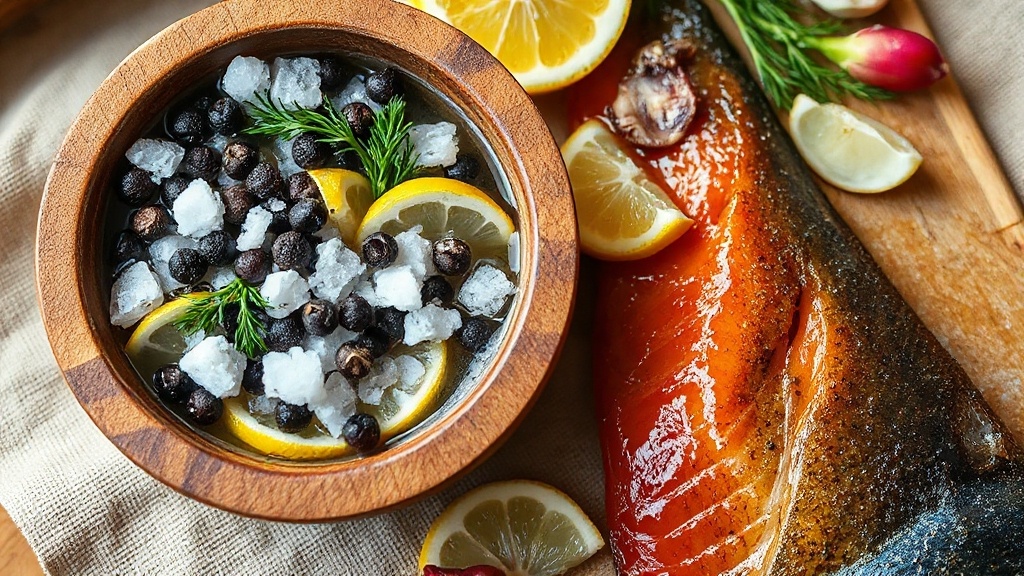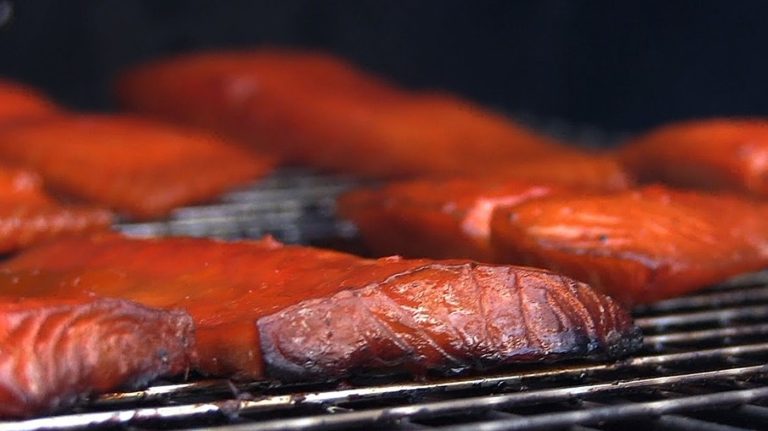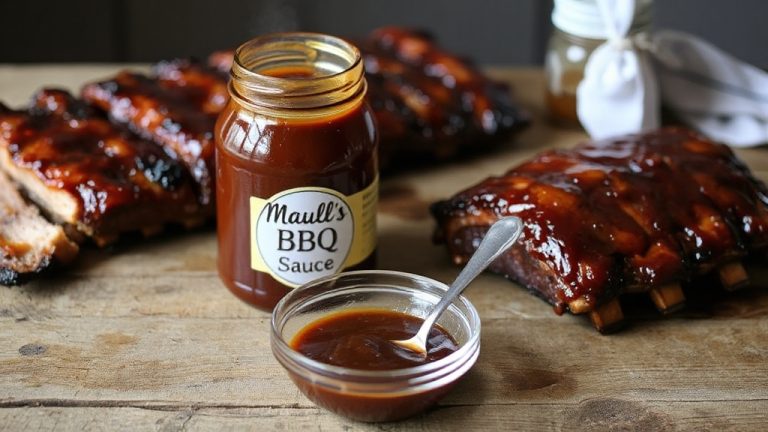Brine Recipe for Smoked Fish: Simple Steps to Juicy Results
To create the perfect brine for smoked fish, combine kosher salt and brown sugar with apple juice or lemon juice, adding garlic, bay leaves, and black pepper for depth.
Dissolve solids fully in water, using a non-reactive container, then submerge your fresh, oily fish—ideally 1 to 1.5 inches thick—for 8 to 12 hours refrigerated.
This balances saltiness and moisture, enhancing smoke absorption and texture. Explore additional techniques to elevate your smoked fish to professional levels.
Key Takeaways
- Use kosher salt and brown sugar in a 1:20 ratio with water to balance saltiness and sweetness in the brine.
- Add aromatics like bay leaves, garlic, celery, onion, and spices such as black pepper and paprika for enhanced flavor.
- Combine all liquids first, dissolve salt and sugar completely, then simmer aromatics for 15–20 minutes and cool before brining fish.
- Fully submerge fish in the cooled brine within a non-reactive container and refrigerate for 6–12 hours depending on thickness.
- Use additional flavor liquids like apple juice, lemon juice, or soy sauce to add complexity and depth to the brine.
Brine Recipe for Smoked Fish Table
| Ingredients | Process |
|---|---|
| Fresh fish (salmon, trout, mackerel) | Select fresh, firm fish with vibrant color. Clean and trim into uniform fillets for even brining. |
| Water: 1 gallon | In a large non-reactive container, pour in the water as the base for your brine. |
| Kosher salt: 1 cup | Add kosher salt to the water. Stir until completely dissolved. |
| Brown sugar: 1 cup | Mix in brown sugar, ensuring it dissolves fully for balanced sweetness. |
| Soy sauce: 1 cup | Pour in soy sauce for a savory depth of flavor. |
| Black peppercorns: 1 tbsp | Add whole black peppercorns for a subtle spice. |
| Garlic cloves: 4, smashed | Smash and add garlic cloves to infuse aromatic notes. |
| Whole cloves: 5 | Drop in whole cloves for a warm, spiced undertone. |
| Dill: 1 tbsp (dried) | Sprinkle in dried dill for a fresh, herbal accent. |
| Optional: Cayenne pepper (1 tsp), lemon zest (1 tbsp), bay leaves (2), crushed red pepper flakes (1 tsp) | Add any or all optional flavorings to customize your brine to taste. |
Essential Ingredients for the Perfect Brine
Although brining may seem straightforward, selecting the essential ingredients with care directly influences the flavor and texture of your smoked fish. You’ll want kosher salt for pure salinity without additives, balanced by brown sugar to introduce sweetness and counteract the salt.
Water serves as the medium, ensuring even ingredient distribution and full fish submersion. It is important to mix ingredients until sugar and salt are fully dissolved and allow the brine to cool to room temperature before use.
Incorporate bay leaves and garlic to infuse subtle herbal and savory notes. For added complexity, consider liquid components like apple juice for sweetness, lemon juice to provide acidity and preservation, and soy sauce to enhance umami depth.
Fresh aromatics such as celery and onion contribute herbal and sweet-savory layers. Finally, black pepper and optional spices like paprika can refine the brine’s flavor profile, allowing you to tailor the taste precisely to your preferred smoked fish outcome.
Preparing and Mixing Your Brine
When preparing your brine, start by accurately measuring ingredients to maintain the ideal balance—typically one part salt to twenty parts water—to guarantee effective curing and preservation. Combining different types of charcoal can influence the overall flavor during smoking, so understanding charcoal composition is beneficial.
Combine all liquids first, including water and any optional elements like soy sauce, before adding salt and brown sugar.
Always mix all liquids together first before incorporating salt and brown sugar for a smooth brine.
Use a non-reactive container, such as glass or plastic, to avoid chemical reactions. Stir or whisk the mixture thoroughly until all solids dissolve completely, ensuring an even cure. It is recommended to use a 3-gallon food-safe bucket for mixing when preparing larger quantities.
If you add aromatics or spices, simmer the brine for 15–20 minutes, then cool it to room temperature before use. Never add fish to hot brine, as this leads to uneven curing and partial cooking.
Cooling can be accelerated in an ice bath, making the brine ready for immediate fish immersion. Proper temperature control and airflow management are essential when smoking fish to achieve the best results.
Selecting the Best Fish for Smoking
You’ll want to select fish with the right fat content and texture, such as salmon or trout, to guarantee ideal smoke absorption and moisture retention.
Ideal Fish Types
Which fish should you choose to achieve the best results in smoking? Focus on oily fish like salmon, mackerel, and herring; their high fat content absorbs smoke flavors efficiently and retains moisture, ensuring rich, textured results.
Leaner options like trout offer milder flavors for less fatty preferences. Tuna, especially the belly, also responds well to smoking due to its oil content.
The tradition of smoking fish dates back thousands of years as a preservation method, highlighting its long-standing culinary value in many cultures as a way to extend shelf life and add flavor through smoke curing.
| Fish Type | Fat Content | Flavor Profile |
|---|---|---|
| Salmon | High | Rich, smoky, oily |
| Trout | Low | Mild, delicate |
| Mackerel | Moderate | Strong, oily, flavorful |
Selecting the right fish optimizes smoke absorption and texture, essential for a successful smoked fish dish.
Fish Freshness Importance
Choosing the right type of fish sets the foundation, but guaranteeing its freshness directly affects the smoking outcome. You’ll want fish with firm flesh, clear eyes, and red gills—key indicators of recent catch and proper handling.
Avoid relying on color since it can vary due to diet or environment. Fresh fish should have a mild, non-fishy smell and be stored constantly on ice or refrigerated to preserve quality.
Fish in rigor mortis are hard to process and unsuitable for smoking, so timing is critical. Freshness reduces microbial load, maintains moisture, and preserves texture and flavor during smoking.
Proper handling and short storage times before smoking are essential. By selecting fresh fish, you ensure a superior smoked product that’s safe, flavorful, and visually appealing.
Additionally, controlling humidity levels during smoking can significantly improve smoke flavor absorption and overall quality.
Size and Thickness
While preparing fish for smoking, paying close attention to size and thickness is essential to guarantee even cooking and ideal flavor absorption. Aim for fillets between 1 to 1.5 inches thick with consistent thickness throughout.
Thicker pieces, commonly preferred, prevent drying out but demand longer brining—typically 12 hours versus 6 to 8 hours for thinner cuts. Uniform thickness ensures the fish smokes evenly, avoiding undercooked or overcooked sections.
Select firm, dense, oily fish like salmon or mackerel, as their texture withstands the smoking process and aids moisture retention.
Adjust your brine duration accordingly, fully submerging the fish to optimize salt and sugar absorption. Use a nonreactive container and refrigerate during brining to maintain the fish’s quality and safety.
Step-by-Step Brining Process
Before you submerge your fish, you need to prepare a well-balanced brine by dissolving kosher salt and brown sugar in water at a 20 to 1 ratio, then enhancing it with herbs or spices.
Bring this mixture to a boil, then reduce to a simmer for 15 to 20 minutes to extract flavors fully. Using a wire rack or mesh pan can help ensure even exposure to the brine and prevent bruising during the process.
After simmering, cool the brine to room temperature to avoid partially cooking the fish. Select a container that allows the fillets to lay flat and be fully submerged. Using kosher salt is essential because it prevents ruining the brine, unlike iodized table salt.
Place the fish in the brine and refrigerate it—thin pieces for 6 to 8 hours, thick chunks for 8 to 12. Ensure the fish stays fully covered to allow even flavor penetration.
Maintaining a consistent temperature during brining is key to achieving optimal flavor and texture. This controlled process maximizes taste and texture, preparing the fish perfectly for smoking.
Tips for Smoking Your Brined Fish
You’ll want to maintain your smoker at around 150°F to guarantee gentle, even cooking that preserves moisture and flavor.
Choosing woods like apple, alder, or cherry will impart complementary smoky notes without overpowering the fish. After smoking, let the fish rest to allow flavors to settle before serving, enhancing texture and taste.
For best results, wrap the fish tightly and rest it in a preheated cooler with insulation to maintain moisture and temperature.
Ideal Smoker Temperatures
Because temperature control directly impacts both the safety and texture of your smoked fish, maintaining an ambient smoker temperature between 150°F and 170°F (66°C to 77°C) is critical for hot smoking.
This range ensures the fish heats evenly and reaches an internal temperature of 160°F (71°C) for at least 30 minutes, effectively killing harmful bacteria while preserving moisture for a flaky texture.
Selecting appropriate wood chips can also enhance the flavor profile, complementing the natural taste of the fish with subtle smoky notes that do not overpower.
Use a digital thermometer to monitor both internal and ambient temperatures closely, avoiding the danger zone of 40-140°F (4-60°C). It is important to note that maintaining 160°F internally for at least half an hour is necessary to ensure the fish is safe to eat.
Key considerations include:
- Gradually raise the smoker temperature to prevent curd formation and texture damage.
- Maintain internal fish temperature above 140°F throughout smoking to preserve moistness and tenderness.
- Allow 6 to 8 hours for the fish to reach the target internal temperature safely.
Best Wood Choices
Maintaining the right smoker temperature sets the stage for flavor development, but selecting the appropriate wood profoundly shapes the final taste of your smoked fish.
For delicate fish, choose alder or apple wood to impart a mild, sweet smoke that won’t overpower. Salmon benefits from cherry wood’s fruity notes, while oily fish like tuna stand up well to hickory or mesquite, adding robust, smoky depth. Alder is particularly favored for its mild flavor profile that complements salmon’s delicate taste.
Always use dry, high-quality wood chips and avoid softwoods such as cedar or pine due to harmful resins. Soak wood chips briefly to ensure slow smoldering and steady smoke production. Properly storing wood chips helps maintain their moisture content and ensures consistent smoke quality during the smoking process.
Experiment by mixing woods—combining alder with cherry, for example—to create nuanced flavors. Monitor smoke density carefully to maintain consistency, aligning your wood choice with the fish type and brine for ideal results.
Controlling the smoke density allows for balanced flavor infusion without overpowering the natural taste of the fish.
Resting and Serving
When you finish smoking your brined fish, allow it to rest briefly to redistribute moisture and improve texture. Keep the fish in a controlled environment, avoiding humidity that could cause sogginess.
Use a thermometer to verify the internal temperature remains above 150°F (65.5°C) during this period, ensuring safety and ideal texture.
Additionally, holding fish at this temperature for a sufficient time helps to kill bacteria and enhance food safety. To maintain consistent results, it is important to monitor internal temperatures carefully during the resting phase.
For serving, focus on presentation and freshness to enhance the eating experience. Serve with lemon wedges, capers, or fresh herbs to complement and elevate flavors.
Store smoked fish in an airtight container, refrigerated below 40°F (4°C), to maintain quality and prevent contamination. Pair with crackers, bread, or sauces like aioli for a versatile and flavorful offering. This approach guarantees both safety and an appealing final product.
Safe Storage and Handling of Smoked Fish
Although smoking enhances fish flavor and preservation, you must store and handle smoked fish carefully to guarantee safety and quality. Refrigerate smoked fish below 40 °F within three hours of purchase and cool rapidly after smoking to prevent toxin formation.
For extended storage, freeze at –20°C or use canning with proper techniques. Always eviscerate fish over five inches and use gloves to avoid contamination. Monitor temperature and time closely to inhibit pathogens like C. botulinum and prevent histamine buildup.
Large batches of smoked fish do not cool rapidly, so adherence to regulated cooling times is essential to control C. botulinum growth. Using precise temperature control during smoking and storage ensures optimal safety and flavor preservation.
| Aspect | Key Practice | Purpose |
|---|---|---|
| Refrigeration | Below 40 °F within 3 hours | Inhibit bacterial growth |
| Evisceration | Remove viscera for >5-inch fish | Control C. botulinum spores |
| Freezing | –20°C for ≥24 hours | Kill parasites and preserve |
| Handling | Gloves and clean utensils | Prevent contamination |
| Monitoring | Temperature and time control | Minimize pathogen proliferation |
Frequently Asked Questions
Can I Reuse Brine for Multiple Batches of Fish?
You shouldn’t reuse brine for multiple fish batches because it risks cross-contamination and bacterial growth. The brine’s salinity drops as it absorbs moisture, reducing its effectiveness and altering flavor and texture.
Even boiling can’t fully sanitize it. To keep your fish safe and flavorful, prepare fresh brine each time. Using fresh brine guarantees consistent quality, prevents toxins, and maintains the right chemical balance for proper curing.
How Do Different Wood Types Affect Smoke Flavor?
Different wood types impact smoke flavor by adding unique taste profiles to your fish. Alder gives you a light, delicate smokiness, perfect for mild fish.
Cedar adds a sweet, rich note, enhancing fatty fish like salmon. Hickory delivers a bold, bacon-like flavor, while maple offers a mild, sweet smoke.
Mesquite brings strong, spicy tones but can overpower delicate fish. Choosing the right wood lets you tailor the flavor complexity to your preference.
What’s the Best Way to Thaw Frozen Smoked Fish?
Did you know thawing smoked fish in the refrigerator can take up to 24 hours but drastically reduces bacterial growth? You should always thaw frozen smoked fish in the fridge for even, safe thawing that preserves texture and flavor.
Place it on a plate or in a sealed bag to catch drips. If time’s tight, cold water thawing works in 20-30 minutes but avoid microwaves or room temperature to prevent spoilage and texture loss.
Can I Brine Fish Without Refrigeration Safely?
You shouldn’t brine fish without refrigeration if you want to keep it safe. Brining relies on low temperatures, typically below 40°F (4.4°C), to prevent harmful bacterial growth like Clostridium botulinum.
Without refrigeration, salt alone can’t guarantee safety, especially during the longer curing times required. If you must brine without cooling, you risk spoilage and foodborne illness. Always make sure proper refrigeration or use validated preservation methods.
How Does Altitude Affect Smoking Time and Temperature?
Think of smoking fish at altitude like hiking uphill—the journey takes longer, and the air feels different. You’ll need to increase smoking time because lower pressure slows heat transfer.
Temperatures might require adjustments since water boils at lower temps, affecting internal cooking. Dryness at altitude speeds moisture loss, so watch closely.
Lower oxygen levels can alter combustion, so maintain steady heat. You’ll want to experiment and monitor carefully for perfect results.
Brine Like a Pro for Smoked Fish That Impresses
Think of your brine like a precision instrument—just as a clock’s gears must align perfectly to keep time, your ingredients need exact balance for ideal flavor and texture. When you follow this recipe carefully, your smoked fish will come out tender, flavorful, and safe to enjoy.
Remember, even a small tweak in salt or sugar can shift the outcome dramatically. Mastering this brine sets the foundation for exceptional smoked fish every time.





